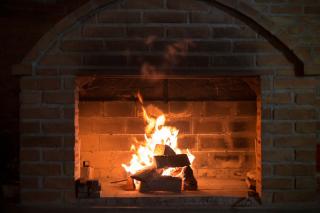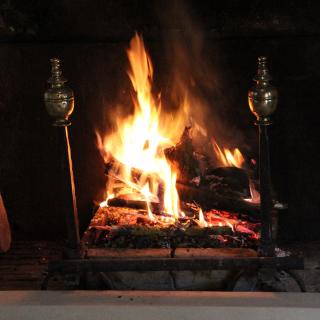Gather Around Hearth-Fires
By Lenore Bajare-Dukes

At this time of year – a cold bite to the air, long dark nights – I feel a deep, almost primal impulse to huddle around a hearth-fire, spending time with people dear to me. At a past CER skill-up call, we reflected on the impulse of humans living in seasonal climates to gather together around hearth-fires in these late fall and winter months. Do you have some hearth-fires in your life? Perhaps it’s a kitchen stove, working to feed yourself and your community around harvest time. Perhaps it’s a flickering movie screen. Or a literal fireplace with some games.
I’ve noticed that when humans do gather around, what emerges is often stories. Stories of where we have been, stories of traditions that have shaped us, stories of the people and places we have been or want to become. Individual stories, which together make up a sort of tapestry of a community.
What if we took this impulse seriously, as a core function of religious community? What better place is there to practice slowing down and gathering around the hearth-fires, than in a congregation? (Yes, even in these over-scheduled times.)
What are you yearning for, this season? What does your congregation or community yearn for?
Where are your community’s hearth-fires which are waiting for you to gather around?
What stories are waiting for you to tell…or to hear?
Part of my work as Congregational Life staff is accompanying congregations that are going through big stuff: significant changes, deep conflicts, big hopes and dreams for big futures. Amid this worthy, big work, it’s easy to forget about the importance and power of very small practices…such as gathering regularly to share stories. But these small practices that weave a community come in handy when the big stuff comes along: when tempers are frayed, or a tough issue comes up in a congregational meeting, we can remind ourselves that we know one another, and we know the stories that have led us to the place from which we speak. When we have a bedrock sense of community — trusting each other, enjoying spending time in community, knowing what welcome feels like to ourselves and to others – that’s what sustains us during times of change and difficulty.
When I think about the moments that have helped me feel a sense of belonging and connection in a community, it’s usually the smaller times: the way someone knew my name and looked glad to see me when I came back after time away. The way a circle at coffee hour expanded to welcome me in—with my interests, my stories, and theirs too.
Cultivating a culture of welcoming and belonging is both a simple skill, and a complex one, which requires that we make space and time to practice. Despite (or perhaps because of) the promise of being in community, it can be painful – disappointing – intimidating to belong to a congregation. And no wonder! How many places do we have in the world where it’s really up to us to make room for the person next to us to connect and belong? Where else are we expected to practice showing up as imperfect, vulnerable humans alongside other imperfect, vulnerable humans? As we aspire to connect across different beliefs, racial and ethnic identities, class and cultural backgrounds, generations – what models out there do we have for doing so with respect and care?

And so, cultivating spaces to share our stories does take some care. We may bring complicated family lives to these hearth-fires. We bring many identities, some painfully misunderstood or targeted within our society. Some of us bring fraught religious pasts. One thing I’ve learned from regularly offering invitations to small spaces for seemingly small stories is that this invites people to come to the communal hearth bringing only what they feel able to offer at this time. Let’s not make the mistake of thinking that only the ‘biggest’ stories – my theological journey, my core moments – are worth sharing. I have found the opposite: that after a group of people have been able to share something that seems very small in their lives, it opens a window to some of the most profound things that make them who they are. And the more we practice slowing down and connecting in these smaller ways, the stronger our communal fabric becomes.
Luckily, humans have been sharing stories of who they are for a very long time now. And we have the power to cultivate small practices of slowing down and sharing within our everyday spaces – coffee hour, interactive time in worship, potlucks – rather than only practicing deep listening and sharing when the stakes are high.
If, like many of us, you could use some practice, here are three resources to help you cultivate those joyful story-sharing spaces around your community hearths this fall and winter season:
- Personal/interpersonal practice: You can participate in StoryCorps’s annual Great Thanksgiving Listen — an initiative that invites people nationwide to honor someone in their lives by recording their story for future generations. Digital tools are available for recording stories with loved ones in the same room, or across distance. Prompts help newer story-listeners find avenues into conversation with the ones who are dear to you.
- Group or congregational practice: The community of InterPlay offers profound, yet easy-to-understand tools for helping communities incorporate storytelling in activities small and large. I have facilitated after-worship coffee hour connections inspired by the InterPlay Storytelling e-book guide for community building by long-time InterPlay facilitator Randy Newswanger (M.Div). (I recommend the “Babbling” and “I could tell you about…” exercises, practiced regularly!)
- Congregational practice: At a congregation where I used to serve as religious educator, the staff team decided one year to put together a Radio Holiday Special: “Holiday Stories Around the Fire.” Putting out a call for congregants to record memories of holiday traditions, recipes, music, or stories of their own holidays, then weaving them together into a radio holiday special-style audio hour, brought joy and connection for the team working on the project and for those listening around their own hearth-fires. Since that project, I have wished for a more regular practice of gathering such stories using the technological tools available to us.
So, this season, I invite you to take a few moments and ask:
Where are the hearth-fires around which your community might gather?
How could your community build in practices of sharing and listening to the small stories of each other’s lives in those spaces?
I hope we can honor these wintering months by taking time to gather around the hearth-fires (whatever those look like in your life), and share with one another some small stories of who we are, how we have come to be, and who we are becoming.